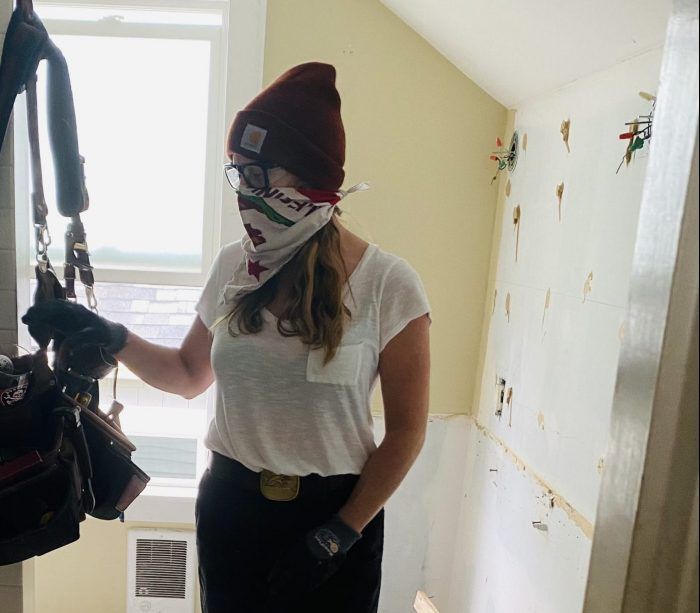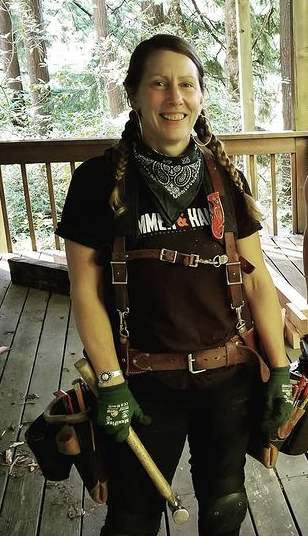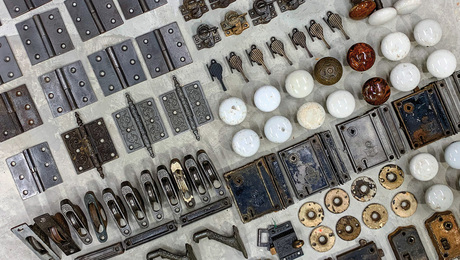Women Do Exist in the Construction Trades
Lead carpenter Carrie Healy talks about what it will take to get more women in the trade and her passion for restoring old homes.

We’re more than two decades into the 21st century and women are still vastly underrepresented in the construction trades. It’s a reality that may see significant change, however, as organizations like the National Association of Women in Construction bring greater visibility and opportunities to women in the trades through initiatives like Women in Construction Week.
Carrie Healy of Portland, Ore., is one woman challenging the stereotype of a tradesperson. A seven-year carpenter recently promoted to Lead Carpenter at Hammer & Hand, and a parent with two kids who love to brag about their mom’s career, Carrie spoke with us about her journey into the trades, her experience of gender at job sites, and what projects she’s got in the pipeline.
Q: How did you get into carpentry?
Carrie: I was a stay-at-home mom for 10 years and had two record shops in Santa Barbara and Ventura in California. We decided to move to Portland when the kids were little, and, when we came up here, I was getting bored as the kids were getting older.
My father was an aircraft mechanic, so I was raised around tools. We constantly worked on cars together and he got me a muscle car for my 15th birthday. And one day I was working on my porch, right around the time I was thinking about going back to work, and a woman drove by and randomly said,” I hope you’re getting paid for that lady!” She told me about Oregon Tradeswomen Inc., which is an all-female program, and it’s free. I had this time where I didn’t have to take time off work—because it’s a three-month program and it’s pretty extensive, so you have to devote the time to it—so it was the perfect time for me to get into it, and I really wanted to put pieces of wood together. I wanted to build, I wanted to frame, and I think framing is still my favorite aspect of what we do. OTI was a very interesting experience because I went into it thinking I wanted to be a carpenter, and the whole point of the program is to open your eyes to all the trades. I almost joined the electrician’s union.
I got my first job before I graduated and have been upgrading ever since. I finally got to Hammer & Hand, which is the company when I was in Oregon Tradeswomen that I knew I wanted to work for. We do very high-end and super-hip remodeling. It was scary because they have amazing carpenters, and when you’re starting out, you have a lot of self-doubt, so it took me a while to gain the confidence to apply for this job.
Q: What have been some of the barriers, mental or external, to learning and progressing in your trade?
Carrie: You are entering a man’s world, to be honest. I was nervous just showing up, and I didn’t know how I was going to compare to men in the field. Turns out, I work circles around a lot of the men I work with. I think as women we have a lot to prove, so we go in strong, really trying to prove that we can do this thing that some people have doubts that you can. Women in the trades add a wonderful element. A lot of things that used to fly don’t fly anymore. It has made everyone slow down and think about the hazing that people used to go through—that sort of thing is in the past. It’s a good thing that women are in the trades in general, even for the men! I think it has been beneficial for them as well.
I was always very confident with tools, and that helped me. A lot of people who were going through Oregon Tradeswomen with me had never picked up a tool in their life. I imagine their experiences are slightly different because that’s the biggest thing—being able to walk to a tablesaw with a sheet of plywood and run it through, and do so gracefully. It took me a year to get comfortable going to work and saying, “I’m doing this, there is nothing standing in my way. I’m not going to let anyone intimidate me to the point that they chase me away.” A lot of men in the beginning would try and “save” me from things, like picking up something heavy. I think keeping your independence and having confidence in yourself is key to being successful.
Portland is very unique in the way that we have a great support system. When you leave OTI, they check in on you constantly; they want to know how you’re doing. They help you buy your first set of everything, like tools and workboots. All of those things cost a tremendous amount of money when you’re first getting started. It’s crucial to invest in yourself, but it’s often very hard because you don’t make a lot of money. Finding a way to reinvest in yourself and buy the tools and gear that you need is crucial, and having help with that is priceless. I’m hoping that a lot of areas will do the same thing and encourage women to get involved.
Q: If you think five years down the line, what is your dream image of women in the trades, and what do we need to get there?
Carrie: I think women need to be aware that it’s an opportunity for them. It needs to be put out there that you could do this. You’re strong enough to do this. You’re smart enough to do this. While the trades do a number on your body, and you’re definitely working hard, a lot of it is just knowledge—having the right tool and knowing what you’re doing—and we’re perfectly capable of doing that. I would like to leave Oregon and see that other women are doing the same things we’re doing here, which is providing free education for women to get enticed. On our city buses and trains in Portland, I always see advertisements for women for OTI. And I think that needs to happen in order for women to even consider doing what I do.

Q: What have been milestone moments in your career that took you to the next level?
Carrie: People, men in particular, standing back and letting me try to do things like giving me the plans and letting me look them over, and then walking away with the confidence that I can do it. And having confidence in myself. My milestones included even just building my first wall. Demo is also very key. When you start out you do a lot of demo and cleanup and what we call the grunt work. And you have to! Demolition is key to understanding how things are put together. And reading and taking notes!
Q: What are your favorite kinds of projects to work on?
Carrie: My favorite kind of projects are old homes. It’s why I decided to do this. I love it. And I am a purist. I don’t want to see a kitchen with modern finishes in a 100-year-old craftsman, ever. We try to keep period. A lot of time, it’s more of a restoration than a remodel. And we reclaim absolutely everything we can. My attic and basement are filled with beautiful pieces of old wood doors and windows. Whether its craftsman, Tudor, or Victorian, keeping it period is important to me.
Q: Do you have any personal projects you’re working on right now?
Carrie: I have so many I think it drives my husband crazy. We do projects together, and we’ve been working on our house a lot. We have a 1924 craftsman, and I mine a lot of things from the houses I remodel that are from the same period. I’m putting my house back to 1924. We just ripped our master bath down to the studs. It was the ugliest thing you’ve ever seen, and now it’s gorgeous. And a lot of the old wood was mined from old houses. I do things for friends and neighbors, but mostly I work on my house. There are so many things I want to do that I know in a lifetime I could never get done.
Photos courtesy of Carrie Healy.
Related Links:
Fine Homebuilding Recommended Products
Fine Homebuilding receives a commission for items purchased through links on this site, including Amazon Associates and other affiliate advertising programs.

Handy Heat Gun

8067 All-Weather Flashing Tape

Reliable Crimp Connectors






















